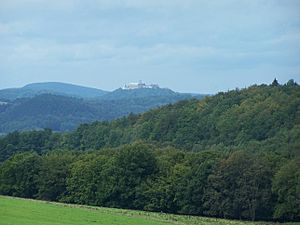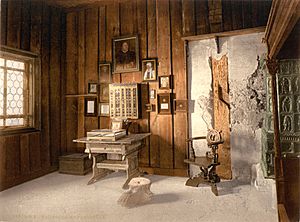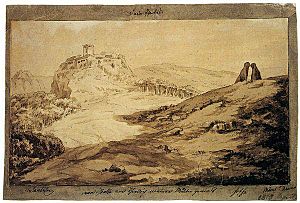Wartburg facts for kids
Quick facts for kids Wartburg Castle |
|
|---|---|
|
Wartburg
|
|
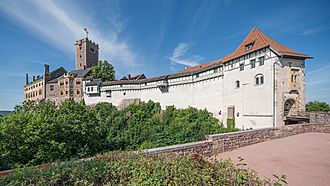
Wartburg in Eisenach
|
|
| Former names | Wartberg |
| General information | |
| Type | Castle |
| Town or city | Eisenach |
| Country | Germany |
| Coordinates | 50°57′58″N 10°18′23″E / 50.96611°N 10.30639°E |
| Construction started | c. 1067 |
| Renovated | 19th and 20th centuries |
| Landlord | Wartburg Stiftung |
| UNESCO World Heritage Site | |
| Criteria | Cultural: iii, vi |
| Inscription | 1999 (23rd Session) |
The Wartburg is an old castle built in the Middle Ages. It sits high up on a hill, about 410 meters (1,345 feet) above the town of Eisenach in Thuringia, Germany. This castle has a rich history! It was once home to Saint Elisabeth, a kind princess known for her charity. Later, Martin Luther hid here and translated the New Testament of the Bible into German. The castle also hosted the Wartburg festival in 1817, a big gathering of students.
Wartburg Castle is a very popular place to visit in Thuringia. Many parts of the castle you see today were built between the 12th and 15th centuries. However, much of the inside was rebuilt in the 19th century. In 1999, UNESCO named Wartburg Castle a World Heritage Site. This means it's a special place recognized for its amazing medieval architecture and its important role in history and religion.
Contents
What's in a Name?
The castle's name, Wartburg, probably comes from the German word Warte, which means "watchtower." It makes sense, as it's a great spot to watch over the land! There's a fun story that says the castle's founder, when he first saw the hill, shouted, "Wait, mountain—you shall bear my castle!" This is a clever play on words in German, using Berg (mountain) and Burg (fortress), along with warte (wait) and Warte (watchtower).
Where is Wartburg Castle?
Wartburg Castle is located on a tall cliff, about 410 meters (1,345 feet) high. It's southwest of the town of Eisenach in Thuringia, Germany, and looks down over the town. The hill is part of the Thuringian Forest. It overlooks a valley called Mariental to the southeast and the Hörsel valley to the north. A very old and important road, the Via Regia, used to pass through this northern valley.
A Look Back in Time: Castle History
Building the Castle
The castle was started around 1067 by a count named Louis the Springer. He was a powerful leader in Thuringia. Wartburg, along with another castle called Neuenburg, helped protect the edges of his lands. Legend says Louis had clay brought from his own land to the top of the hill. This way, he could truthfully say the castle was built on his soil, even though the hill wasn't quite his at first!
The castle was first mentioned in a written record in 1080. It was called Wartberg back then.
A Hub for Poets and Princes
From 1172 to 1211, Wartburg Castle was a very important place for princes and nobles in the Holy Roman Empire. A ruler named Hermann I invited famous poets like Walther von der Vogelweide and Wolfram von Eschenbach to his court. Wolfram von Eschenbach even wrote part of his famous story, Parzival, here around 1203.
The castle became the setting for a legendary singing contest called the Sängerkrieg. Many famous poets, known as Minnesänger, supposedly took part in 1206 or 1207. This legend later inspired the composer Richard Wagner to write his opera Tannhäuser.
Saint Elisabeth's Story
At just four years old, Saint Elisabeth came to Wartburg Castle. She was sent there to be raised and later marry Ludwig IV of Thuringia, the Landgrave. From 1211 to 1228, she lived in the castle and became known for her amazing kindness and charity. She helped many poor and sick people. Elisabeth married Ludwig in 1221. After Ludwig died in 1227, she continued her charitable work. She passed away in 1231 at the age of 24 and was made a saint of the Roman Catholic Church just five years later.
Changes and Challenges
In 1320, the castle had to be rebuilt after a fire caused by lightning. A chapel was added to the main building, called the Palas. Wartburg remained the home of the Thuringian rulers until 1440.
Martin Luther's Secret Stay
From May 1521 to March 1522, Martin Luther stayed hidden at Wartburg Castle. He used the name Junker Jörg (Knight George) to stay safe. This was after he was kicked out of the church by Pope Leo X and refused to change his beliefs. While at the castle, Luther worked incredibly hard. In just ten weeks, he translated the New Testament from ancient Greek into German. His translation quickly became the most famous and widely used German Bible.
A Castle in Decline and Revival
Over the next few centuries, the castle was not used as much and started to fall apart. This happened especially after the Thirty Years' War. However, the main palace and the bailiff's house were always kept in good enough condition. Other buildings, like the keep, fell into ruins and had to be replaced later.
In 1777, the famous writer Johann Wolfgang von Goethe stayed at Wartburg for five weeks. He drew many pictures of the castle buildings.
On October 18, 1817, the first Wartburg festival took place. About 500 students gathered at the castle. They celebrated Germany's victory over Napoleon four years earlier and the 300th anniversary of Luther's Reformation. They also spoke out against old ways and called for Germany to become a united country. This event and another gathering in 1848 were important steps towards German unification.
Reconstruction and a Lost Treasure
Later, Grand Duke Karl Alexander ordered the castle to be rebuilt starting in 1838. He and his wife, Princess Sophie of the Netherlands, wanted to restore it as an important national monument. The castle was rebuilt in a style that looked like old Romanesque buildings. The main architect, Hugo von Ritgen, worked on it for his whole life, and it was finished a year after he passed away in 1889.
The Grand Duchess Maria Pavlovna and her son Karl Alexander also started an art collection at the castle. This collection became the beginning of today's museum.
After World War II, a valuable collection of weapons and armor from the castle disappeared. These items were taken by Soviet forces in 1946 and their location is still unknown. The collection included about 800 pieces, like armor belonging to kings and popes. A few pieces were found later or returned in the 1960s.
Under communist rule in East Germany (GDR), more reconstruction happened from 1952 to 1954. The main palace was largely restored to its original Romanesque look.
In 1967 and 1983, the castle was a central place for big celebrations. These included the castle's 900th anniversary and Martin Luther's 500th birthday.
Castle Architecture
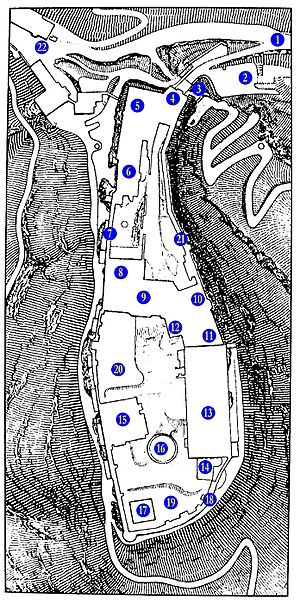
Wartburg Castle has many interesting parts. Let's explore some of them!
The Palas: Main Building
The Palas is the largest building at Wartburg. It was built in the late Romanesque style between 1157 and 1170. It's considered one of the best-preserved Romanesque buildings that isn't a church, north of the Alps.
Inside the Palas, you'll find rooms like the Rittersaal (Knights' Hall) and the Speisesaal (Dining Hall). These rooms have been carefully restored to look like they did in the Romanesque period. Some rooms even have original wooden ceilings! Many rooms also show the style of the 19th and 20th centuries. For example, the Elisabeth-Kemenate has beautiful mosaics showing the life of Saint Elisabeth. The Sängersaal (Singers' Hall) has frescoes (wall paintings) by Moritz von Schwind that show the legendary Sängerkrieg. This hall was even the inspiration for a similar hall in Neuschwanstein Castle.
Other Cool Castle Parts
- Drawbridge and Barbican: These are the only ways to get into the castle. They look much like they did in medieval times.
- Vorburg: This is the area just inside the first gate. It has several half-timbered buildings from the 14th and 15th centuries.
- Lutherstube: This is the room in the Vogtei (Bailiff's lodge) where Martin Luther stayed. It has paintings by Lucas Cranach the Elder.
- Bergfried (Keep): This tall tower was finished in 1859. It stands on the foundations of an older medieval tower and has a large cross on top.
- Neue Kemenate (New Bower): This building, from 1853–1860, now holds the castle's art treasures. You can see paintings by Lucas Cranach the Elder and sculptures here.
- Südturm (South Tower): Built in 1318, this Romanesque tower is one of the oldest parts of the castle, along with the Palas. It even has a dungeon below!
In 1999, UNESCO added Wartburg Castle to the World Heritage List. They called it an "Outstanding Monument of the Feudal Period in Central Europe" because of its important cultural value.
Visiting Wartburg Castle Today
Wartburg Castle is a very popular place for tourists. It's the most visited site in Thuringia after Weimar. Visitors can explore the castle and take guided tours to see inside the buildings. There's also a museum in the castle. Kids can even ride donkeys up the hill to the entrance! The Festsaal (Festival Hall) is still used for concerts and even performances of the opera Tannhäuser. Right next to the castle, there's a hotel that was built during the castle's reconstruction in the 19th century.
Many important people have visited Wartburg Castle. For example, Bill Clinton, who was the 42nd president of the United States, visited on May 14, 1998.
Wartburg's Lasting Impact
For hundreds of years, Wartburg has been a special place for many people. It's important in German history and in the story of Christianity. Because of its significance, several places, especially towns in the United States founded by Lutherans, have been named after Wartburg. Even a local brand of car was once called Wartburg! Wartburg College and Wartburg Theological Seminary, both in Iowa, USA, are named to remember Martin Luther's time at the castle.
The Wartburgkreis (Wartburg District) is also named after the castle, even though the castle itself is just outside the district's borders.
Images for kids
See also
 In Spanish: Castillo de Wartburg para niños
In Spanish: Castillo de Wartburg para niños


